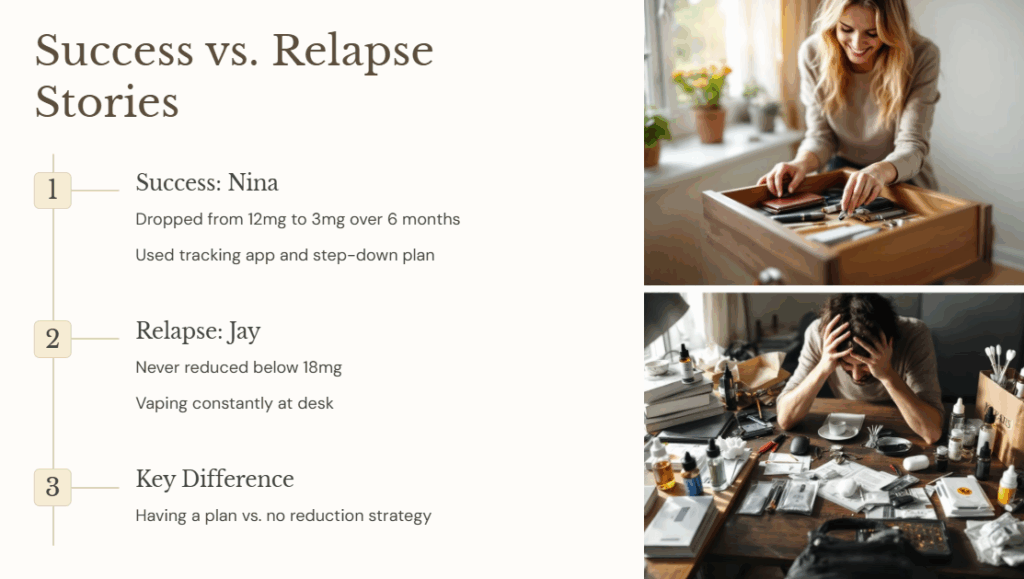I’ll admit it, when I first tried to quit smoking, I wasn’t looking for the perfect method. I just wanted something that worked and fast. That’s when I started wondering, “Can I switch to a vape to quit smoking… without just getting addicted to something else?”
Turns out, I’m not alone.
Many smokers turn to vaping with good intentions: to escape the chokehold of cigarettes. But somewhere along the line, that little device becomes a new crutch and before you know it, you’re vaping in your car, in your house, and maybe even more than you smoked.
So, let’s break this down:
Can you actually quit smoking with a vape without becoming addicted?
Let’s take a hard, honest look.
Why Do So Many Smokers Turn to Vaping to Quit?
For a lot of people (myself included), the logic goes like this:
- Smoking is dangerous. Everyone knows it.
- Vaping seems less harmful.
- Maybe I can gradually reduce nicotine by using a vape.
- Bonus: No ash, no stink, no social judgment.
But here’s where the fear kicks in:
“What if I just trade one addiction for another?”
That’s the core anxiety. We want freedom, not a new chain.

Vaping vs. Smoking: What Really Causes Addiction?
At the heart of both smoking and vaping lies nicotine, a chemical that hijacks the brain’s reward system by triggering dopamine, the “feel good” neurotransmitter. The faster nicotine hits your system, the more addictive it tends to be.
- Cigarettes deliver nicotine quickly via combustion.
- Vapes can deliver nicotine just as fast, especially high-concentration salt-based ones.
- Both can create or maintain a physical dependency.
Studies from the Johns Hopkins show that vaping isn’t a “safe” way out[1][2], but it can be a stepping stone if managed carefully.
The Misconception: Is Vaping Less Addictive?
You might’ve heard people say:
“Vaping is fine. I’m not even addicted.”
But the truth is nuanced.
Yes, vapes can contain lower levels of nicotine, and some let you choose 0mg nicotine options. But without a plan, it’s easy to:
- Use your vape more often (because it’s socially acceptable indoors)
- Choose higher nicotine formulations “just for now”
- Create a habit loop that’s psychological, even if not fully physical
Bottom line: Vaping can be addictive too, especially with regular or high-nicotine use.
Exposure to tobacco—especially in e-cigarette form—can cause long-term respiratory problems and trigger conditions like allergic rhinitis or chronic nasal inflammation.
👉 If you’re dealing with nasal congestion or inflammation, you may find relief through simple at-home strategies.
Real Stories: Who Quits Successfully with Vaping—And Who Doesn’t?
Let’s look at both sides.
✅ Success Story: Nina, 33
“I started with 12mg nicotine in a vape and dropped down to 3mg over 6 months. I used a quitting app to track my usage and reminded myself daily that the goal was ZERO.”
- Tools used: Nicotine-tracking app, behavioral coaching, nicotine step-down plan
❌ Relapse Story: Jay, 45
“I ditched cigarettes and felt great at first… but started vaping constantly. I never went below 18mg nicotine and now I’m basically vaping all day at my desk.”
- What went wrong: No plan to reduce use, psychological dependency worsened, high nicotine

How to Use Vaping Without Getting Addicted
Okay, so now for the big question—Is it possible?
Yes. But here’s the catch: Only if you treat vaping like a temporary tool, not a permanent replacement.
🛠️ Practical Tips for Quitting with Vape (Without Getting Hooked):
- Start with the lowest effective nicotine dose—and don’t go up.
- Create a tapering schedule—just like you would with medication.
- Switch to 0mg nicotine e-liquids gradually.
- Track your usage—know when you’re reaching for it out of habit, not need.
- Pair with behavioral tools—counseling, quit apps, or accountability partners.
Fun fact: According to the Penn Medicine, nicotine-free vaping can damage blood vessels[3], so it’s important to address the why behind the cravings.
My Experience: The Hard Truth
Personally, I used a vape to quit smoking 2 years ago. Did it help? Yes. Did I get addicted to the vape? Also yes—for a while. It took real effort to cut down and eventually put the vape away too.
The difference came when I stopped asking “is this better than smoking?” and started asking:
“Does this still control me?”
Can You Quit Smoking with a Vape Without Getting Addicted?
Yes—but only with discipline and a real exit plan.
Vaping isn’t a magic fix. It’s a potential bridge, not a destination. And while it may feel “safer,” it still keeps you tethered if you don’t use it with purpose.
So if you’re serious about quitting, pair your vape with:
- Gradual nicotine reduction
- Mindful use
- Professional support
- Clear intentions
And remember—every step away from nicotine counts, even if it’s not perfect.
Nasal health can significantly impact how we breathe and overall respiratory comfort. Interestingly, studies have also shown that early exposure to nasal irritants—including smoke and pollutants—can increase the risk of developing chronic rhinitis or allergies in young people.
To learn more about how youth are exposed to harmful substances like tobacco, check out our post on
Q&A: What People Are Asking
Q1: Can I use vape just occasionally without getting addicted?
Yes, but be careful. Even occasional nicotine can reignite cravings. Try 0mg options.
Q2: Is nicotine-free vape totally safe?
Safer than smoking, yes—but not completely risk-free. Some flavorings may still irritate lungs.
Q3: Is vaping really less harmful than smoking?
Generally yes, because it lacks combustion. But less harmful isn’t the same as harmless.
Q4: Can vaping help me quit cigarettes for good?
Yes, especially when combined with a tapering plan, apps, and behavioral support.
Q5: How long should I vape before quitting completely?
It varies. Many people taper over 3–6 months. Talk to a specialist to personalize your plan.
Reference
- [1] Johns Hopkins, What Does Vaping Do to Your Lungs?
- [2] Johns Hopkins, 5 Vaping Facts You Need to Know
- [3] Penn Medicine, Nicotine-Free E-Cigarettes Can Damage Blood Vessels

